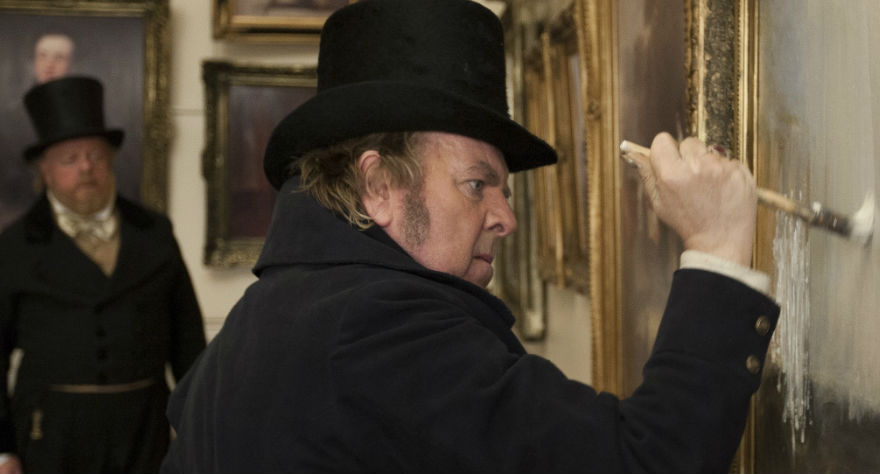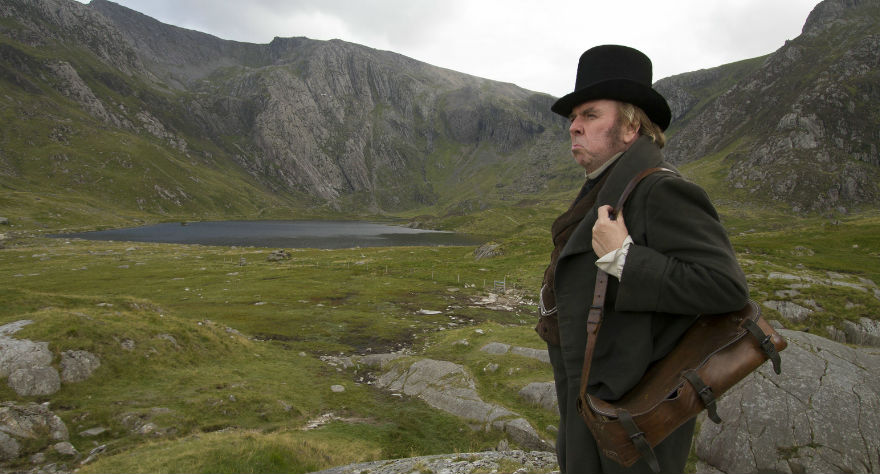
Spall's seamless performance combined with the immaculate set and costume design and stunning photography makes for a film that feels more like a time machine than a period piece.

Spall's seamless performance combined with the immaculate set and costume design and stunning photography makes for a film that feels more like a time machine than a period piece.
English landscape painter JMW Turner, commonly exalted as “the painter of light”, was one of the great artists of the 19th century, his work considered by art historians something of a precursor to the impressionist movement. It’s perfect, then, that Mike Leigh‘s marvelous Mr. Turner takes an impressionistic approach to exploring Turner’s character, focusing on intimate, revelatory, and often unflattering moments in the late painter’s life, stressing truth over historical accuracy while never shattering Turner’s mystique. Unlike your typical artist hagiography, Mr. Turner doesn’t attempt to cram every significant event and accomplishment of Turner’s life into a filmic nutshell. It does something much better: it gives us a sense of what it would feel like to be in Turner’s presence, in a time when he still sauntered around above soil.
As you may have picked up on from all the awards buzz overrunning every movie site on the internet (including us), Turner is played by the phenomenal Timothy Spall in what, for my money, is the best performance of 2014. When you look at Turner’s oil and watercolor masterpieces, of churning oceans under thunderclouds and placid lakes under sun-drenched bridges, you may imagine a slender fellow wearing fancy clothes, gently kissing the canvas with his brush, held between three fingers. Spall, as you may have noticed, isn’t slender or fancy or gentle, and as Turner he’s straight-up bestial, a tubby slob communicating mostly in growla, grunts, and groans, holding his paintbrush with a fist and violently thrusting it onto the canvas in a motion of controlled chaos.
Turner’s artistic prowess is always evident, but the pervading fact is that he’s mostly an ordinary, middle-aged man with as many flaws as the drunk down the street at the local tavern. He’s a boor and a womanizer, using his maid as a sex toy whenever he feels the compulsion (Dorothy Atkinson overachieves in a small, but significant role). He’s an absentee father, refusing to acknowledge his daughters’ presence in the rare occasion that they work up the courage to visit the old pig with their mother, his former mistress (the wonderful Ruth Sheen). The only aspect of his life he treats with a measure of class is his vocation, a field in which he’s driven, committed, and uncompromising. His artistic legacy and reputation is of utmost importance to him (he staunchly refuses to sell his collection to a dignitary for an ungodly amount of money, insisting that his work remain accessible to the public), and he views his colleagues as competitors and rivals.

Leigh’s lucid insight into what makes the mind of an artist tick is fascinating. So often is the artistic process romanticized and idealized in film, but here Leigh states plainly that not every artistic achievement is inspired by some life catastrophe or eternal adoration of a muse or lover. Many of the notable things we see happen to Turner–from his beloved father (Paul Jesson) dying, to finding a soul mate on his frequent trips to Margate in widow Sophia Booth (a fantastic Marion Bailey)–don’t seem to shape or inform his artistic endeavors at all. This contradicts everything we’ve been conditioned to think about art and artists in movies, and it’s a rejuvenating, eye-opening experience to watch it all unfold.
The contradictory nature of Turner is reflected in the film’s painterly imagery, which frames his physically grotesque figure with environments and landscapes as beautiful and richly colored and textured as his paintings. Seriously, it’s staggering how pretty this movie is; cinematography snobs will gawk or pass out from the glory of it all. For Leigh and cinematographer Dick Pope to achieve the same level of artistry with their moving images as Turner did on canvas is mind-boggling, and yet, they’ve damn well done it. (This is coming from an art history layman, mind you. Art geeks, don’t kill me.)
It all just feels so right and whole and meant to be. Every shot and camera movement is deliberate and precise. Every line of dialogue (yes, even the growls and snorts) expresses just enough. I’ve not in years seen an onscreen character that feels as fully-realized as Turner, and Spall’s seamless performance combined with the immaculate set and costume design and stunning photography makes for a film that feels more like a time machine than a period piece. It’s hard to imagine Leigh, Spall, and their team improving upon what they put forth in this transcendental masterpiece.